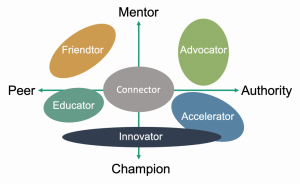
News
Building Your Cadre of Mentors
Finding a good mentor is like getting a personalized self-help book, one that is full of insightful questions and practical guidance tailored to you. A traditional mentor focuses on guiding your personal growth. However, you can receive a wide array of guidance from a variety of perspectives when you work together with someone, so let’s expand our vocabulary a bit and use the word Collaborators as a more general term.
Just like you wouldn’t need five copies of the same self-help book, it’s useful to have different types of Collaborators, each playing a different role. The alignment chart below illustrates a variety of Collaborators based on the people I have found particularly valuable in my life. The goal of this diagram is to help you identify any gaps in your current cadre and opportunities to round out your group. And the best part, meeting up with one of these Collaborators only costs about as much as a cup of coffee! (usually)

In this chart, the horizontal axis reflects the Collaborator’s relationship to you; your peers are on the left while those with more seniority, formal authority, or clout are on the right. The vertical axis depicts the Collaborator’s perspective on guidance. The guidance you get from people at the top of the vertical axis helps you with personal growth, while the guidance from people at the other end of the axis helps you solve problems or champion solutions.
When I think of a traditional mentor, I think of an Advocator in the upper right quadrant. As someone with clout who can help you grow career-wise, they’ve been in your shoes and can give you advice. Advocators also know other authority figures with whom they can share your accomplishments; they’re the Collaborator who can help you get your next promotion. I find advocating for yourself and having others advocate for you is an important way to gain visibility in your community.
In the upper left side is the Friendtor, a peer who you trust to give more personal advice. They walk the line of friend and mentor, so they know all the best things about you but can also point out your flaws. I personally ask my Friendtors for advice on team dynamics and navigating conversations with my leadership.
An Educator straddles the line in the lower left quadrant. They are someone with specific domain knowledge about the problem you’re trying to solve. An Educator’s role is to teach you skills or information relevant to your work and are the Collaborator you’re most likely to shadow. I’ve found Educators to be closer to a peer than an authority figure, but that’s not always the case.
An Innovator is a Collaborator who is a problem-solving powerhouse, and they span the whole bottom half of the chart. Innovators can either have a background in your problem area or can be someone with a fresh perspective – both mentalities can be incredibly useful depending on your situation. People who embody the mindset of Team Toolkit are my go-to Innovators.
Solidly in the lower right Authority/Champion quadrant is the Accelerator – think of them as someone who will help catapult your idea. They’ve got high-powered connections and stay up to date with the current trends. The strategic prowess of an Accelerator means they are the ones who can help develop and refine your idea. These Collaborators are moving quickly from success to success and can help you do the same.
Finally, at the center of this chart is a person with a wide network, the Connector. They’re the Collaborator who seems to know everyone. Having a Connector introduce you to someone they know personally is often more successful than cold-emailing someone with whom you want to grab a virtual coffee. They can be your gateway to many of the other Collaborators in this chart.
I hope this post has helped you view mentors through a new frame of reference. If you have any questions, feel free to reach out and grab a virtual cup of coffee (or tea!) with me.
This article is by Gabby Raymond, one of our Team Toolkit Members
Originally posted on the Innovation Toolkit Website. Click here to link to post.
